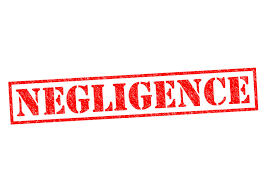NEGLIGENCE: LAW OF TORTS :- Our Legal World
INTRODUCTION
In our day to day life, the word ‘negligence’ means nothing else but mere ‘carelessness’. In general sense, negligence means the act of being careless and in legal sense, it signifies the failure to exercise a standard of care to the individual which a doer as a reasonable man should have exercised in the situation. It is been committed in respect of both person and property.
DEFINITION
Some of the important definitions of Negligence are as follows:-
- According to Prof. Winfield
Negligence is the breach of legal duty to take care, which results in damage, undesired by the defendant to the plaintiff.
- According to Baron Alderson
Negligence is the omission to do something which a reasonable man guided upon the those consideration, which ordinarily regulate human affairs, would do or doing something, which a prudent or reasonable man would not do.
In Lochgelly Iron & Coal Co. v. M.C. Mullan;
Lord Wright said, “Negligence means more than headless or careless conduct, whether in commission or omission; it properly connotes the complex concept of duty, breach and damage thereby suffered by the person to whom the duty was owing”.
ESSENTIAL ELEMENTS OF NEGLIGENCE
An act will be categorised as negligent, when all these conditions stated below are fulfilled:-
- Duty of care
It may be considered as the essential element in negligence in order to make a person liable. As duty, it is an obligation on one person to another to take care of, if violated due to which harm is caused is negligence. Every person owes, a duty of care towards another person while performing an act. It is legal responsibility of a person to avoid any behaviours or omissions that could be foreseen to cause harm to others.
For example:- A duty of care is owed by the accountant in correctly preparing customer’s tax return, to minimise the chance of IRS audit.
- Duty must be towards the plaintiff
It is not sufficient that the defendant owed a duty of care towards the plaintiff. A plaintiff in the case, must prove a legally recognised harm, in the form of injury to him or to property, like a car in car accident. The failure to exercise a duty must result in injury or damage to whom the defendant owed a duty of care and injury must be brought to the courts within time.
In case, Donoghue v. Stevenson;
It has evolved the principle, that everyone has some duty of care towards their neighbour and or someone we could expect to be affected by our acts or omissions. Therefore it was held , as there was no contract existed between the manufacturer and the person suffering the damage the action for negligence could succeed since the plaintiff was successful in his claim that she was been entitled the duty of care even thought the defective good, i.e., the bottle of ginger beer with snail in it was bought not by herself, but by her friend.
- Breach of duty to take care
Breach, in simple word means misconduct itself, the defendant’s improper act or omission. Normally being , referred as the defendant’s breach of duty. Therefore, this element states that, it is not enough for plaintiff to prove that the defendant owed them duty of care, the plaintiff must also prove that the negligent party(i.e., defendant) breached his duty of care to the plaintiff.. A defendant breaches his duty of care by failing to exercise his reasonable care in fulfilling his duty.
In Municipal corporation of Delhi v. Sushila Devi;
A person passing by the road died because of fall of branch of tree standing on road on him. The Municipal Corporation was held liable.
- Cause in Fact
In this element, to prove causation it should not be enough for the plaintiff to prove that defendant’s conduct caused the harm, the plaintiff must link his damage to the defendant’s negligence and the aspect of the conduct that breached a duty to the plaintiff. Therefore, causation provides the central negligence element that links the defendant’s wrong to the plaintiff’s harm.
Let’s take a example:-
A is driving a truck and is approaching an intersection with a green light. As he goes through the intersection, a vehicle driven by B(random person) collides with A. An investigation on the case stated that B ran a red light. Therefore, clearly it is been shown that the action of B (running the red light) caused the accident. Hence, B is liable for the damage and actual cause is clearly established.
- Proximate cause
Proximate cause relates to the scope of a defendant’s responsibility in negligence. A defendant in negligence is only responsible for the harm which he could have foreseen through his actions. It is, the act or an event which is closely related to the injury. It must be the primary or predominant cause of the injury.
- Consequential harm to the plaintiff
The last essential of negligence states that the damage caused to the plaintiff was the result of breach of duty which defendant owes to plaintiff.. It is must to be proved that failure to exercise reasonable care to the plaintiff resulted in damages.
Harm may fall in types:-
- Physical harm
- Harm to property (land and building etc.)
- Harm to reputation
- Mental harm
- Financial loss
When such damages stated above are proved, then the defendant had to compensate for the damages to the plaintiff.
In Achutrao Haribhau Khodwa v. State of Maharashtra;
A cotton mop was left inside the body of the patient by negligence of a doctor. Therefore, Doctor was held liable for the damages for the carelessness been shown towards their patient.
DEFENCES FOR NEGLIGENCE
In an action for negligence, following defences are available:-
- Contributory Negligence
Contributory negligence in law, is the defence in which the plaintiff himself contributes to his injury or loss ,(i.e., immediate cause of damage is the negligence of the plaintiff himself). The plaintiff cannot sue the defendant for damages and the defendant can use it as defence.
It is based on the maxim, Volenti non fit injuria which states, if someone willingly puts himself into a position which may cause harm, they are not entitled to claim for damages caused by such harm.
- Act of God or Vis Major
Act of God is the direct and sudden act of nature which by any amount of human sight could have foreseen and if foreseen could not by any amount of skill or care could be resisted.
Such acts are extraordinary fall of rain, high tide, storm etc.
Rule of Strict Liability & Absolute Liability under Law of Torts
In Nichols v. Marsland;
The defendant had artificial lakes on his land. There had been no negligence on the part of the defendant in the construction and while maintaining it . Due to an exceptional heavy rain, some of the reservoirs burst and carried away four country bridges. It was held by the court that, the defendant was not liable since the water escaped by an Act of God.
- Inevitable Accident
An inevitable accident is that which could not possibly be prevented by the exercise of ordinary care and skill. It is an accident which is physically unavoidable and cant be prevented by human skill or foresight.
In case, Holmes v. Mather;
A pair of horse were been driven by the defendant on public highway. On barking of dogs, the horse started running fast. The defendant made the best possible efforts to control them but failed. The horses knocked down the plaintiff resulting in serious injury to him.Therefore, it was held that, it was an inevitable accident and the defendant should not be made liable.
In Brown v. Kendal;
The plaintiff’s and the defendant’s dog were fighting while, the defendant was trying to separate them, he accidentally hit the plaintiff in his eye who was standing nearby. The plaintiff brought suit against the defendant for assault and battery, hence it was held that the injury was the result of inevitable accident .
CONCLUSION
Negligence as a tort, as been discussed is the breach of duty of care that is owed to another person. It is conduct which shows carelessness or omission in exercising their duty. In order to prove that the act was negligent, it is necessary to prove all essentials of the act. As also stated, defences can be used in a suit by the defendant to defend himself from the suit been issued by plaintiff.
REFERENCES
- http://www.legalservicesindia.com/article/1297/Negligence-As-A-Tort:-Meaning-Essentials-And-Defences.html
- https://www.google.co.in/amp/s/blog.ipleaders.in/negligence-in-the-law-of-torts/amp/
- https://www.toppr.com/guides/legal-aptitude/law-of-torts/negligence-tort-law/
- https://www.srdlawnotes.com/2017/12/theories-of-negligence-meaning.html?m=1







